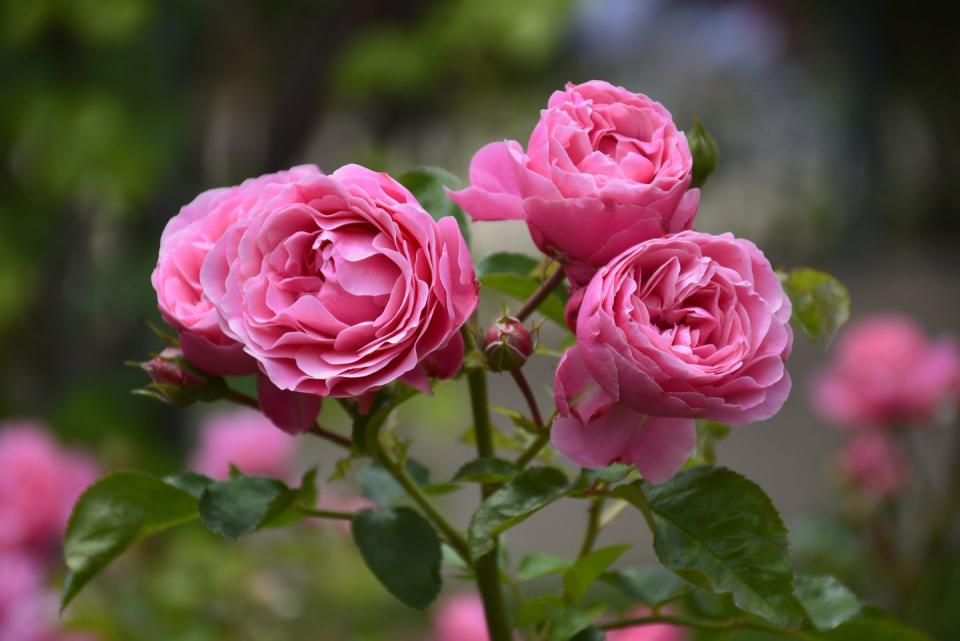Everything You Need to Know About Planting Roses in Your Garden
Loved and cultivated for centuries worldwide, roses are an absolute must in just about any garden! With their gorgeous forms, colors, and fragrances, there are so many types of roses to add to your flower garden. They bloom year after year with little coddling, making them a great addition to any landscaping ideas you're considering. If you want to learn how to plant roses in your garden, then you've come to the right place!
Although they sometimes have a fussy reputation, hybrid roses are much more resilient so even newbie gardeners can grow them. “Breeding has come a long way so that new roses are more disease-resistant than old heirloom types,” says Kristen Smith, rose evaluation manager with Star Roses and Plants. “Roses are versatile, too, because they’re drought-tolerant once established, adapt well to most soil types, and work in any garden setting.”
There are several different categories of roses, which may vary depending on who’s describing them. In general, some of the most popular types include: hybrid tea, grown for cutting and display with their large, lush blooms; climbing roses, which can be trained to grow up a trellis or arbor; and shrub or landscape roses, which are a bush form that grow in most climates. Shrub roses come in various sizes from groundcovers to shrubs that reach about 4 feet tall.
Now that you're well acquainted with the various roses out there, read on to learn all about planting roses and taking care of them for years to come.
When is the best time to plant roses?
Spring and fall are the best times to plant roses. That's because temperatures aren't extreme at these points in the year and therefore aren't stressful for the plants. But you won't want to plant roses any later than August or early September in cold climates. Planting them early enough helps the plants can get established before winter, says Smith.

Where should I plant roses?
First, you'll want to find a spot that gets at least six or more hours of direct sunlight per day. Then, you need to make sure your roses have plenty of space to grow. Plant them at least 2 to 3 feet away from other plants and 4 or 5 feet from your house or other structures so that air can circulate around them. This helps the foliage dry quickly, which aids in preventing disease, Smith notes.
How do I plant roses?
Okay, now that you know when and where to plant roses, it's time to find out exactly how to plant them. Follow these easy steps and you'll be a rose-planting pro in no time.
Dig a hole about twice the width and depth of the pot.
Place the plant in the hole at the same level as it is in the pot, then replace the soil around the plant, and pat down lightly.
Water your newly planted roses deeply, so that the hydration gets all the way down to the roots.
Add a layer of mulch 2 to 3 inches deep to retain moisture and keep down weeds, which compete for nutrients and water. Don't put the mulch right up against the stems because that invites disease and pests.
And that's it! Now, if you're planting bare root roses—which are sold with no soil around them—you can follow the same steps. Just make sure that the area where the stems start is planted at ground level.
Do roses need fertilizer?
It’s fine to mix in organic fertilizer, such as compost, into the planting bed. However, you don’t need to add fertilizer the first year because roses usually have enough in their root ball from the nursery to last the season. After the first year, you can fertilize with a slow-release granular or liquid fertilizer. Follow the package directions and start fertilizing in the spring. You can stop by late summer so that the plant doesn’t push new growth that may be damaged by an early frost.
How do I water roses?
Watering roses is a bit of an art because it depends on how much rain you’re getting, how quickly the soil drains (for example, sandy soil drains faster than clay), and what the humidity levels are. Watch the new plant closely for the first month; you don’t want it to stay soggy or dry out completely, says Smith. Poke your finger in the soil every couple of days to get a feel for the moisture level, then water as needed, especially if you haven’t gotten much rain.
How do I prune roses?
Roses do benefit from an annual trim in late winter or early spring. You don’t have to get overly fussy to get it right—just eyeball it and trim back by about two-thirds of its size, says Smith. It’s also fine to trim off spent blooms if you like a neater look, although it’s not necessary.
How can I protect roses from diseases and pests?
Buying a new type of disease-resistant hybrid, as opposed to heirloom varieties, is your best bet for avoiding diseases and bugs. Diseases such as powdery mildew, which appears when temperatures are cool and moist, often goes away once temperatures heat up.
As far as pests go, aphids and Japanese beetles sometimes are an issue for roses, but they usually don't cause too much harm to the plant. You can use a blast of water from the hose to knock down aphids, pick beetles off by hand, or consider an organic oil product to keep them off. If your plant is hit hard by pests and has dropped about one-third of its foliage, contact your local county extension agent to determine the best approach.

